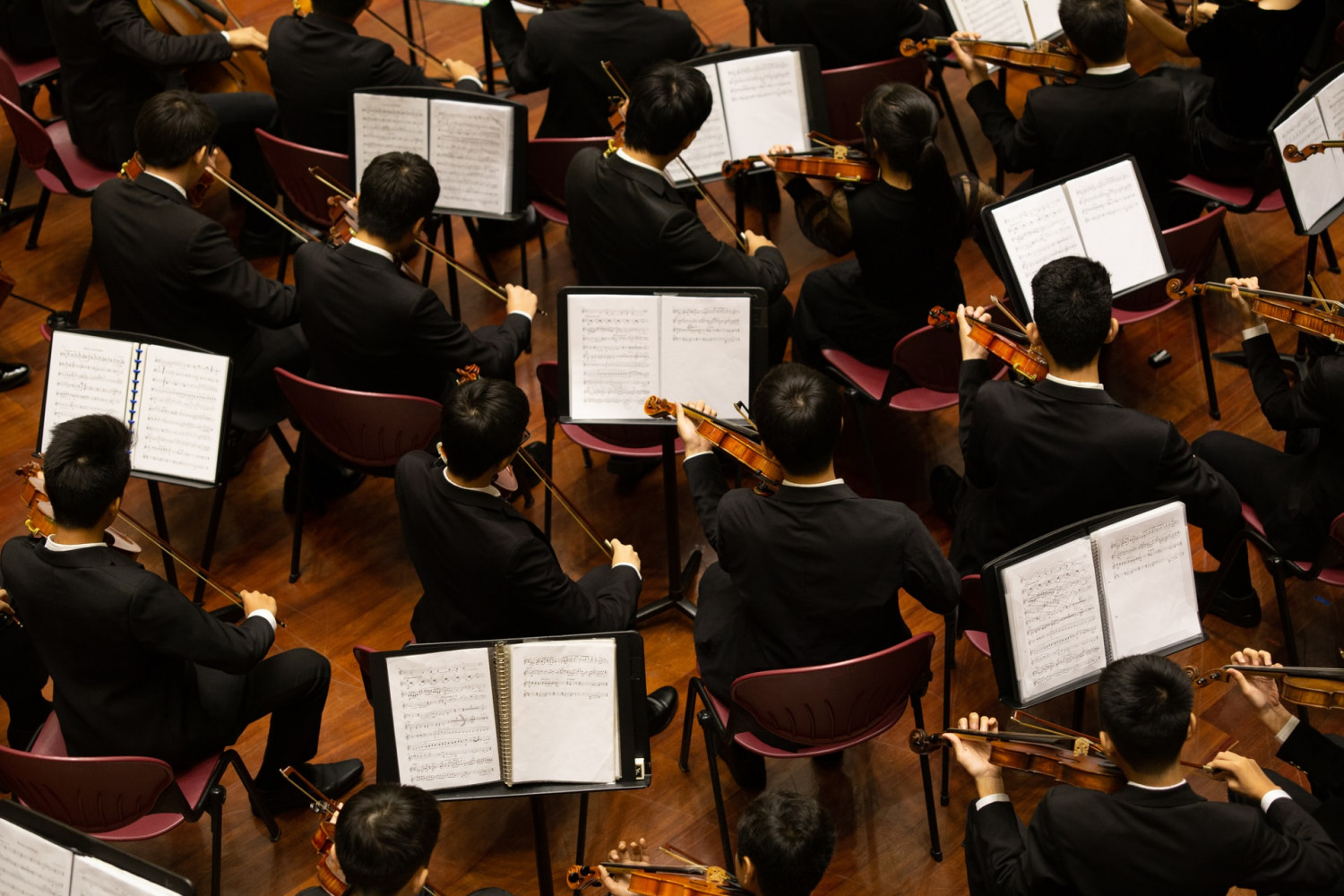

Want to know what a symphony orchestra is
and why they do what they do?
We can help!
What Is A Symphony Orchestra?
A symphony orchestra is a collection of up to about 100 musicians who play instruments of four basic types:
Strings
Violins (smallest and highest in pitch), violas, cellos, and double basses (largest and lowest in pitch). These players sit in a
semicircle directly in front of the conductor, and make up more than half the orchestra.
Woodwinds
Flutes, oboes, clarinets, bassoons, and related instruments. These players sit a few rows back from the conductor, in the center of the orchestra.
Brass
Trumpets, horns, trombones, tubas, and similar instruments. These instruments are the loudest, so you'll see them at the back of the orchestra.
Percussion
The drums, bells, and other fascinating paraphernalia that are struck, plucked, rubbed, etc. This includes the kettledrums, the harp, and, on occasion, the piano. Some works use lots of different percussion; others may have a single musician playing the kettledrums, or no percussion at all. The percussion section is also found at the back of the orchestra.
Who Is The Concertmaster, and What Does He Do?
The concertmaster sits in the first chair of the violins and makes decisions regarding bowing and other technical details of violin playing for the violins, and sometimes all of the string players. He/she leads the orchestra in tuning before concerts and rehearsals, and other technical aspects of orchestra management.
Why Are The Musicians Playing Before The Concert?
Just like basketball players taking shots and practicing moves before the game, musicians need to warm up their muscles and focus their concentration. This is fun to listen to and to watch.
Some of them are working on the passages they need to polish up before the performance. They are practicing by themselves, with no regard for what anyone else is practicing.
Pick out the flute or the trumpet playing a solo line over and over, and listen to how it changes. Does it get smoother? If the player stops in the middle and starts over, can you hear the reason why? It's especially fun to recognize these solos later in the performance! Give a silent cheer for the player who nails the solo.
Not all of the orchestra players practice onstage, of course. Just like the audience, everyone is doing their own thing. Some are talking; others are paging through their music. And some don't come onstage at all until a minute or two before the performance. But at concert time, everyone is in place and ready to start.
Why Are There So Many Strings?
The sound of each individual stringed instrument is quieter than a brass or a woodwind instrument. In large numbers, they make a magnificent, rich sonority, and that's why there's so many.
Why Do All The Musicians Tune To The Oboe?
The penetrating tone of the oboe is easy for all players to hear. Its ability to sustain a single pitch is very secure. The oboe plays the note "A," and all the players make sure their "A" is exactly on the same pitch as the oboe's. This ensures that they all are in agreement about the tuning before the concert starts.
Why Do The Bows Move Together?
The players of each individual section-first violins, second violins, violas, cellos, and double basses-play in unison most of the time. All the cellos move together, for instance. As you listen, noticing the different bowings for each section gives you a visual clue to sort out the various melodies you're hearing.
Why Do The Musicians Wear Formal Black Clothes?
This is a long tradition that started a few centuries ago. Sometimes, these days, musicians dress a little more casually. But they still try to look uniform, so that the audience can concentrate on the music. Soloists are the exception; they often dress differently, because they are the focus of attention.
Why Do The String Players Share A Music Stand?
Fewer stands mean that the musicians, who are moving around quite a bit, have more room to play freely. Also, because the strings play more continuously than the other parts, their page turns can fall in inconvenient places where there should be no break in the music. Look closely and you'll see that the player on the outside keeps playing, while the player on the inside briefly stops playing to turn the page.
Why Does The Conductor Leave After Each Piece of Music?
This provides the conductor a little breather-a chance to collect his or her thoughts before starting the next piece. If the applause is very enthusiastic, the conductor will come onstage again, bow, and perhaps recognize some musicians who played important solos in the piece. The conductor may depart again once or twice before moving on to the next piece on the program.
Why Don't The Musicians Smile?
Look closely and you'll see that some of them do! But in general, they are concentrating deeply, just like outfielders waiting for the fly ball or pitchers winding up to a curve ball. They're in the zone.
After the music is over, you may see them smiling broadly. If it was a concerto, and they liked the soloist's playing, they won't just smile-the string players will tap their stands with their bows as a sign of appreciation.

